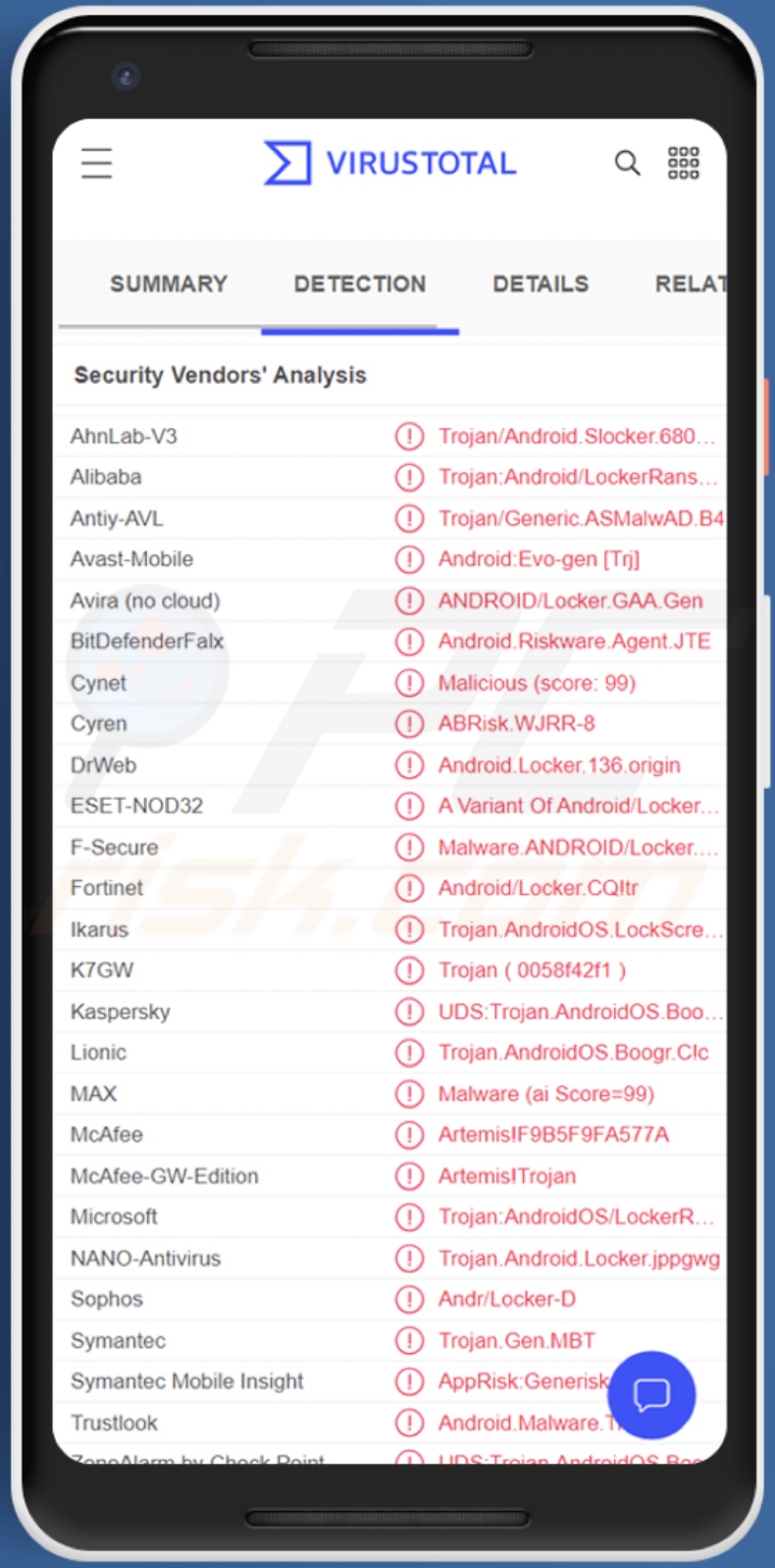How to remove Screen Locking malware from your Android device
RansomwareAlso Known As: Screen Locking ransomware
Get free scan and check if your device is infected.
Remove it nowTo use full-featured product, you have to purchase a license for Combo Cleaner. Seven days free trial available. Combo Cleaner is owned and operated by RCS LT, the parent company of PCRisk.com.
What is Screen Locking malware?
Screen Locking malware refers to screenlocker-type ransomware programs that target Android operating systems. There are numerous variants of this malware, but they differ from previously observed Android screenlockers due to the novel techniques that they use. This is a high-end screenlocker family which boasts multiple variants and a continuously evolving methodology.
The goal of this malware is to push victims into paying a ransom in order to remove the messages that prevent them from using their devices. Unlikely other ransomware types, these screenlockers do not encrypt victims' files.

Screen Locking malware overview
Screenlockers are designed to lock screens by displaying ransom-demanding messages, which - if victims comply with - promise to restore access to the device. Some screenlockers also encrypt victims' files - however, that is not the case with this Screen Locking malware family.
The group in question is notable as it employs new persistence and obfuscation techniques. Previously analyzed malicious programs of this kind primarily used either the Android Accessibility Services (designed to help users who need additional aid in interacting with their devices) or the "SYSTEM_ALERT_WINDOW" permission (allows windows to take precedence over others) - to display the ransom notes.
However, preventative measures and security solutions exist for these and other methods used by this ransomware type. The new techniques employed by this malware family are sophisticated and ensure better chances at evasion, as well as have low detection rates.
These screenlockers combine the "call" notification that has top priority and the "nUserLeaveHint()" Android callback method. Hence, the screen-locking message is displayed persistently on every window.
Since there are numerous versions of this malware - there are just as many variations in language, wording, and appearance. Therefore, the ransom notes can be disguised as fines issued by authorities or plainly identify the attackers as hackers. This also includes a variety of ransom sizes and payment methods.
It must be mentioned that in many cases, access to the device is not restored even though victims meet the cyber criminals' demands. Therefore, we strongly advise against paying and thus supporting this criminal activity.
If your Android device is infected with Screen Locking malware, we highly recommend removing it without delay.
| Name | Screen Locking ransomware |
| Threat Type | Android Malware, Malicious Application, , Screenlocker, Screen Locking Malware, Ransomware, Crypto Virus. |
| Detection Names | Avast-Mobile (Android:Evo-gen [Trj]), DrWeb (Android.Locker.136.origin), ESET-NOD32 (A Variant Of Android/Locker.CQ), Kaspersky (UDS:Trojan.AndroidOS.Boogr.gsh), McAfee (Artemis!F9B5F9FA577A), Full List (VirusTotal) |
| Distribution methods | Infected email attachments, malicious online advertisements, social engineering, deceptive applications, scam websites. |
| Damage | The screen is locked and the device cannot be used without paying a ransom. Additional password-stealing Trojans and malware infections can be installed together with a ransomware infection. Stolen personal information (private messages, logins/passwords, etc.), decreased device performance, battery is drained quickly, decreased Internet speed, huge data losses, monetary losses, stolen identity (malicious apps might abuse communication apps). |
| Malware Removal (Windows) |
To eliminate possible malware infections, scan your computer with legitimate antivirus software. Our security researchers recommend using Combo Cleaner. Download Combo CleanerTo use full-featured product, you have to purchase a license for Combo Cleaner. 7 days free trial available. Combo Cleaner is owned and operated by RCS LT, the parent company of PCRisk.com. |
Android-targeting screenlocker malware examples
We have analyzed dozens of malicious programs that target Android operating systems. DoubleLocker, Hackerz, and Cyberpunk 2077 mobile ransomware are a couple examples of malicious programs that both lock the device's screen and encrypt files.
How did Screen Locking malware infiltrate my device?
Cyber criminals proliferate malware by using phishing and social engineering tactics. Screen Locking malware is spread just the same - with various instances of these programs being disguised as existing apps, pirated games, video players, and so on.
Criminals often distribute Android malware via the Google Play Store. However, distribution through dubious download channels (e.g., freeware and third-party websites, P2P sharing networks, etc.) is more common since there is less risk for swift discovery and removal of the malicious content.
Other popular malware proliferation methods include drive-by (stealthy/deceptive) downloads, online scams, spam mail (e.g., emails, SMSes, PMs/DMs, etc.), illegal software activation tools ("cracks"), fake updates, and malvertising (malicious ads).
How to avoid installation of malware?
We strongly recommend researching applications prior to download/installation and/or purchase, e.g., by reading installation terms and user reviews, checking out the developers, taking note of necessary permissions, etc.
Furthermore, all downloads must be performed from official and verified sources. It is just as important to activate and update software with legitimate tools, as illegal activation ("cracking") tools and third-party updaters may contain malware.
We advise against opening the attachments and links found in suspicious/irrelevant mail (emails, SMSes, PMs/DMs, etc.) - since that can result in an infection. Another recommendation is to be vigilant when browsing - as fraudulent and malicious content typically appears legitimate and harmless.
We must emphasize the importance of having a dependable anti-virus installed and kept up-to-date. Security programs must be used to run regular system scans and to remove detected threats and issues.
Appearances of the screen-locking message displayed by this malware:
Quick menu:
- Introduction
- How to delete browsing history from the Chrome web browser?
- How to disable browser notifications in the Chrome web browser?
- How to reset the Chrome web browser?
- How to delete browsing history from the Firefox web browser?
- How to disable browser notifications in the Firefox web browser?
- How to reset the Firefox web browser?
- How to uninstall potentially unwanted and/or malicious applications?
- How to boot the Android device in "Safe Mode"?
- How to check the battery usage of various applications?
- How to check the data usage of various applications?
- How to install the latest software updates?
- How to reset the system to its default state?
- How to disable applications that have administrator privileges?
Delete browsing history from the Chrome web browser:

Tap the "Menu" button (three dots on the right-upper corner of the screen) and select "History" in the opened dropdown menu.

Tap "Clear browsing data", select "ADVANCED" tab, choose the time range and data types you want to delete and tap "Clear data".
Disable browser notifications in the Chrome web browser:

Tap the "Menu" button (three dots on the right-upper corner of the screen) and select "Settings" in the opened dropdown menu.

Scroll down until you see "Site settings" option and tap it. Scroll down until you see "Notifications" option and tap it.

Find the websites that deliver browser notifications, tap on them and click "Clear & reset". This will remove permissions granted for these websites to deliver notifications. However, once you visit the same site again, it may ask for a permission again. You can choose whether to give these permissions or not (if you choose to decline the website will go to "Blocked" section and will no longer ask you for the permission).
Reset the Chrome web browser:

Go to "Settings", scroll down until you see "Apps" and tap it.

Scroll down until you find "Chrome" application, select it and tap "Storage" option.

Tap "MANAGE STORAGE", then "CLEAR ALL DATA" and confirm the action by taping "OK". Note that resetting the browser will eliminate all data stored within. This means that all saved logins/passwords, browsing history, non-default settings and other data will be deleted. You will also have to re-login into all websites as well.
Delete browsing history from the Firefox web browser:

Tap the "Menu" button (three dots on the right-upper corner of the screen) and select "History" in the opened dropdown menu.

Scroll down until you see "Clear private data" and tap it. Select data types you want to remove and tap "CLEAR DATA".
Disable browser notifications in the Firefox web browser:

Visit the website that is delivering browser notifications, tap the icon displayed on the left of URL bar (the icon will not necessarily be a "Lock") and select "Edit Site Settings".

In the opened pop-up opt-in the "Notifications" option and tap "CLEAR".
Reset the Firefox web browser:

Go to "Settings", scroll down until you see "Apps" and tap it.

Scroll down until you find "Firefox" application, select it and tap "Storage" option.

Tap "CLEAR DATA" and confirm the action by taping "DELETE". Note that resetting the browser will eliminate all data stored within. This means that all saved logins/passwords, browsing history, non-default settings and other data will be deleted. You will also have to re-login into all websites as well.
Uninstall potentially unwanted and/or malicious applications:

Go to "Settings", scroll down until you see "Apps" and tap it.

Scroll down until you see a potentially unwanted and/or malicious application, select it and tap "Uninstall". If, for some reason, you are unable to remove the selected app (e.g., you are prompted with an error message), you should try using the "Safe Mode".
Boot the Android device in "Safe Mode":
The "Safe Mode" in Android operating system temporarily disables all third-party applications from running. Using this mode is a good way to diagnose and solve various issues (e.g., remove malicious applications that prevent users you from doing so when the device is running "normally").

Push the "Power" button and hold it until you see the "Power off" screen. Tap the "Power off" icon and hold it. After a few seconds the "Safe Mode" option will appear and you'll be able run it by restarting the device.
Check the battery usage of various applications:

Go to "Settings", scroll down until you see "Device maintenance" and tap it.

Tap "Battery" and check the usage of each application. Legitimate/genuine applications are designed to use as low energy as possible in order to provide the best user experience and to save power. Therefore, high battery usage may indicate that the application is malicious.
Check the data usage of various applications:

Go to "Settings", scroll down until you see "Connections" and tap it.

Scroll down until you see "Data usage" and select this option. As with battery, legitimate/genuine applications are designed to minimize data usage as much as possible. This means that huge data usage may indicate presence of malicious application. Note that some malicious applications might be designed to operate when the device is connected to wireless network only. For this reason, you should check both Mobile and Wi-Fi data usage.

If you find an application that uses a lot of data even though you never use it, then we strongly advise you to uninstall it as soon as possible.
Install the latest software updates:
Keeping the software up-to-date is a good practice when it comes to device safety. The device manufacturers are continually releasing various security patches and Android updates in order to fix errors and bugs that can be abused by cyber criminals. An outdated system is way more vulnerable, which is why you should always be sure that your device's software is up-to-date.

Go to "Settings", scroll down until you see "Software update" and tap it.

Tap "Download updates manually" and check if there are any updates available. If so, install them immediately. We also recommend to enable the "Download updates automatically" option - it will enable the system to notify you once an update is released and/or install it automatically.
Reset the system to its default state:
Performing a "Factory Reset" is a good way to remove all unwanted applications, restore system's settings to default and clean the device in general. However, you must keep in mind that all data within the device will be deleted, including photos, video/audio files, phone numbers (stored within the device, not the SIM card), SMS messages, and so forth. In other words, the device will be restored to its primal state.
You can also restore the basic system settings and/or simply network settings as well.

Go to "Settings", scroll down until you see "About phone" and tap it.

Scroll down until you see "Reset" and tap it. Now choose the action you want to perform:
"Reset settings" - restore all system settings to default;
"Reset network settings" - restore all network-related settings to default;
"Factory data reset" - reset the entire system and completely delete all stored data;
Disable applications that have administrator privileges:
If a malicious application gets administrator-level privileges it can seriously damage the system. To keep the device as safe as possible you should always check what apps have such privileges and disable the ones that shouldn't.

Go to "Settings", scroll down until you see "Lock screen and security" and tap it.

Scroll down until you see "Other security settings", tap it and then tap "Device admin apps".

Identify applications that should not have administrator privileges, tap them and then tap "DEACTIVATE".
Frequently Asked Questions (FAQ)
My Android device is infected with Screen Locking malware, should I format my storage device to get rid of it?
Most malicious programs can be removed without resorting to such drastic measures.
What are the biggest issues that Screen Locking malware can cause?
As its name implies, Screen Locking malware is designed to deny users access to their device by locking its screen. The aim is to force victims to pay a ransom - with the hope that the cyber criminals will unlock the device. It is noteworthy that there are no guarantees that by meeting the ransom demands - access will be restored; in fact, it is often the case that the device remains locked. In summary, these infections can lead to data loss, severe privacy issues, and financial losses.
What is the purpose of Screen Locking malware?
Screen Locking malware, like most malicious programs, is used to generate revenue. However, cyber criminals also use malware for their own amusement or to carry out personal grudges, disrupt processes (e.g., websites, services, etc.), and even launch politically/geopolitically motivated attacks.
How did Screen Locking malware infiltrate my Android device?
Malicious software is usually disguised as or bundled with ordinary content, and Screen Locking malware has been observed under the guise of various legitimate applications, "cracked" games, video players, etc. The most commonly used malware distribution techniques include: untrustworthy download sources (e.g., freeware and third-party sites, Peer-to-Peer sharing networks, etc.), spam mail (e.g., emails, text messages, PMs/DMs, etc.), online scams, illegal program activation tools ("cracks"), fake updates, and malvertising.
Share:

Tomas Meskauskas
Expert security researcher, professional malware analyst
I am passionate about computer security and technology. I have an experience of over 10 years working in various companies related to computer technical issue solving and Internet security. I have been working as an author and editor for pcrisk.com since 2010. Follow me on Twitter and LinkedIn to stay informed about the latest online security threats.
PCrisk security portal is brought by a company RCS LT.
Joined forces of security researchers help educate computer users about the latest online security threats. More information about the company RCS LT.
Our malware removal guides are free. However, if you want to support us you can send us a donation.
DonatePCrisk security portal is brought by a company RCS LT.
Joined forces of security researchers help educate computer users about the latest online security threats. More information about the company RCS LT.
Our malware removal guides are free. However, if you want to support us you can send us a donation.
Donate


▼ Show Discussion